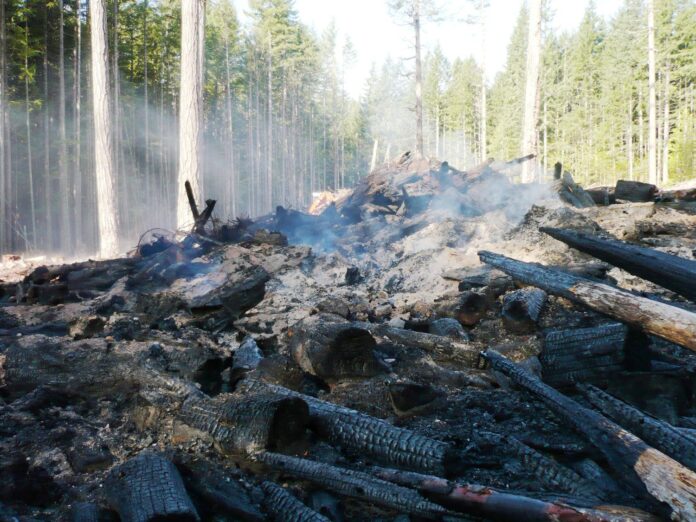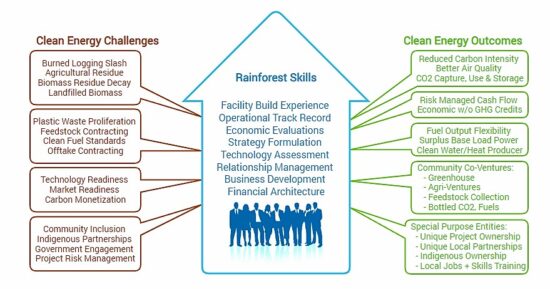A new, private company, Rainforest Energy Corporation, plans to build biorefinery processing facilities in multiple sites to convert forest and agriculture waste into “clean fuels.”
Is Clean Fuel Green?
Rainforest hopes to produce fuel substitutes not derived from extracting oil or gas, but rather from the waste products of forestry (burn slash) and agriculture, the latter not to be confused with crops like corn purposely grown to produce ethanol. These synfuel-derived alternates would include gasoline, diesel, and propane substitutes.
The company intends to capture the carbon dioxide (CO2) as well from its biorefineries and through partnerships sequester it underground, use it in other industrial processes, or be source material for carbon composites and other high-value products like carbon-infused cement.
Rainforest feedstock includes forestry logging detritus as its main source for biorefinery operations. That means wherever forest operations exist, a Rainforest biorefinery can be operated to divert slash-burn waste into synfuels rather than into greenhouse gas (GHG). It seems to be a worthwhile cause and by the look of it, profitable as well.
How does Rainforest technology work? It begins by dehydrating the forest waste feedstock. It then gasifies that waste in closed chambers where oxygen is injected. Instead of incineration, gasification occurs transforming the waste into a syngas that contains unwanted byproducts including CO2, nitrogen, tars, chlorine, hydrogen and trace metals. The syngas can then be converted into gasoline, diesel, and propane. Chemicals can treat and remove unwanted byproducts and the CO2 can be captured.
So Are These Synfuels Green?
As much as Rainforest would like you to believe they are producing a green product, it is not the case. When syngas is used to make synfuel, the downstream end result is that it gets burned in an internal combustion engine. The byproduct of that combustion includes CO2, methane, and carbon monoxide. So that means capturing the GHGs has to happen at the tailpipe in addition to at the point of production to be zero-carbon.
Rainforest acknowledges that the processes it intends to use are not new. The technologies already exist including methane reforming which is used today by fossil fuel companies. CO2 capture is also a growing industry that includes many different methodologies well beyond the concept stage.
But if the timelines experienced by these companies are any measure of how quickly the biorefinery operations can get up and running, my guess is this will not be a quick turnaround. It has taken more than a decade to get pilot carbon capture projects up and running, and another decade to scale them to start capturing millions of tons of CO2 annually. Meanwhile, our industrial civilization continues to pump out gigatons of the stuff contributing to global heating.
It should also be stated that biorefineries that produce syngas don’t solve climate change. What they do represent is a way to harvest the energy potential from waste that today gets burned in slash piles in forests. It redirects emissions from the forest floor to when internal combustion engines use the synfuels, pushing the emissions downstream.
So the big thing I get from learning about Rainforest is that it uses biomass to produce fuel rather than allowing that biomass to be burned where it is produced or carted off to be put into landfills. This is its added value. And capturing CO2 and other greenhouse gas byproducts in its processes also provides value.
But Rainforest is definitely not green. Maybe greener is a better definition because, in the end, the synfuels it produces will cause GHGs. Until there is 100% electrification of transportation and electrification gets adopted across other industrial sectors, Rainforest biorefineries are, therefore, no more than a transitional stopgap.
Don’t get me wrong. Burning forest waste is a significant contributor of GHGs. Wherever forestry is practiced, the burning of slash waste is a common practice. Every Rainforest biorefinery could stop this. Each would be able to take 200,000 tons of slash-burn waste annually and eliminate 404,000 tons of greenhouse gas emissions from forest slash-burn sources. The captured CO2 can be stored underground, or repurposed. And with thousands of sites around the world, Rainforest biorefineries could do some good. But you can’t call the operations green.
Check out the infographic below which summarizes the business case. Through multiple partnerships with government and industry, the company hopes to roll out hundreds if not thousands of these biorefineries. As a transitional strategy to achieve net zero emissions by 2050, there is a place for Rainforest. But calling it a green solution – it just ain’t so.










